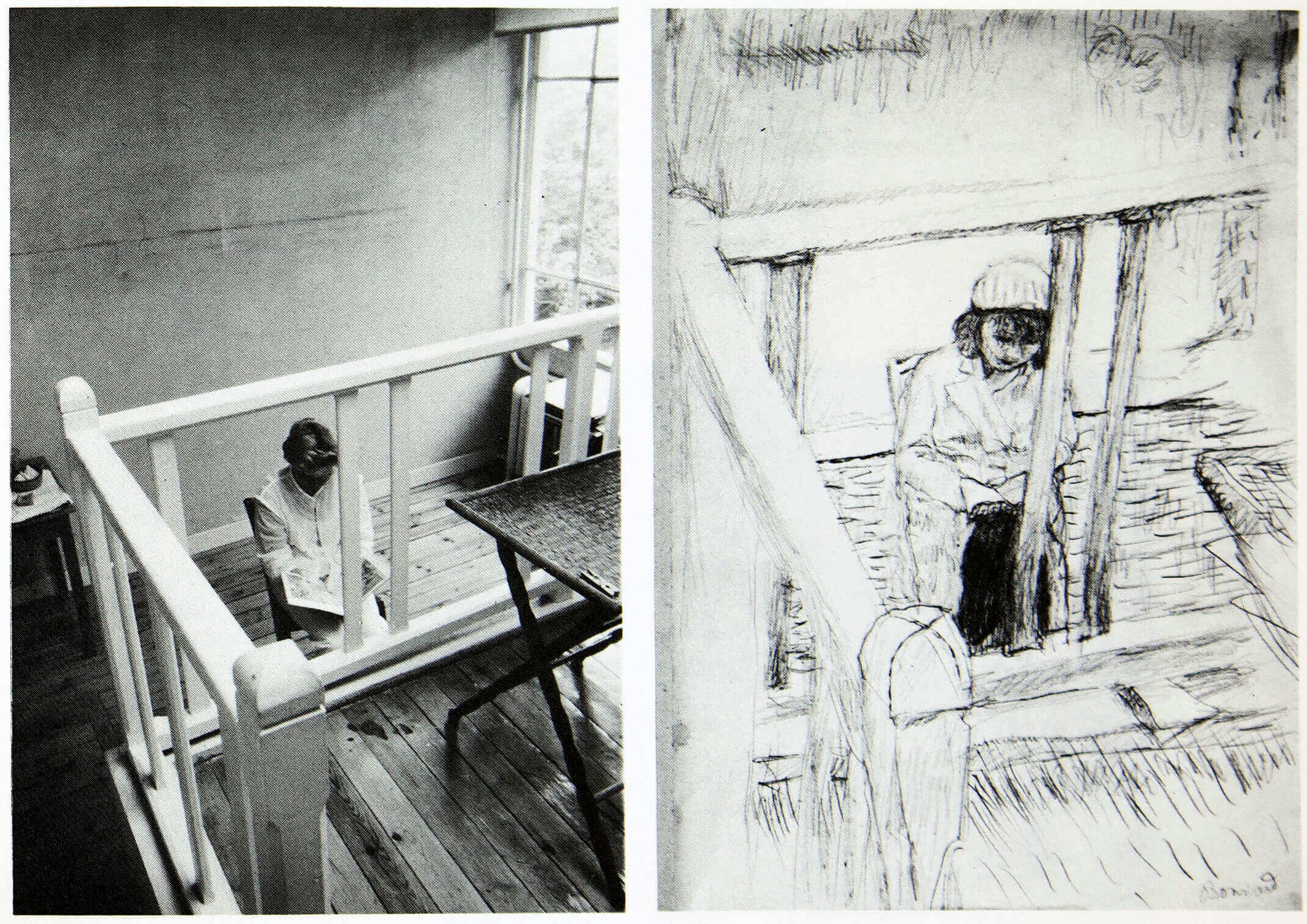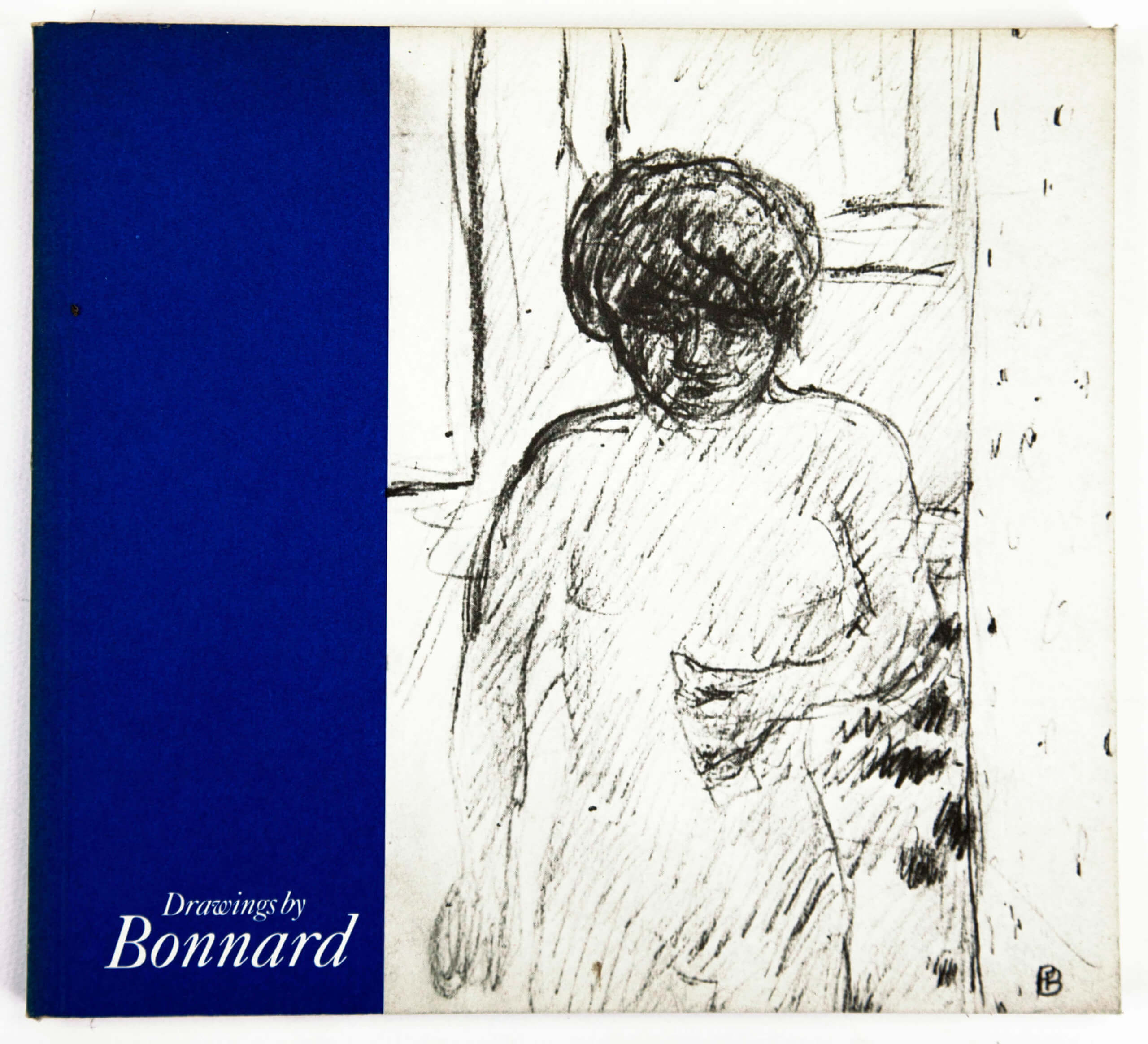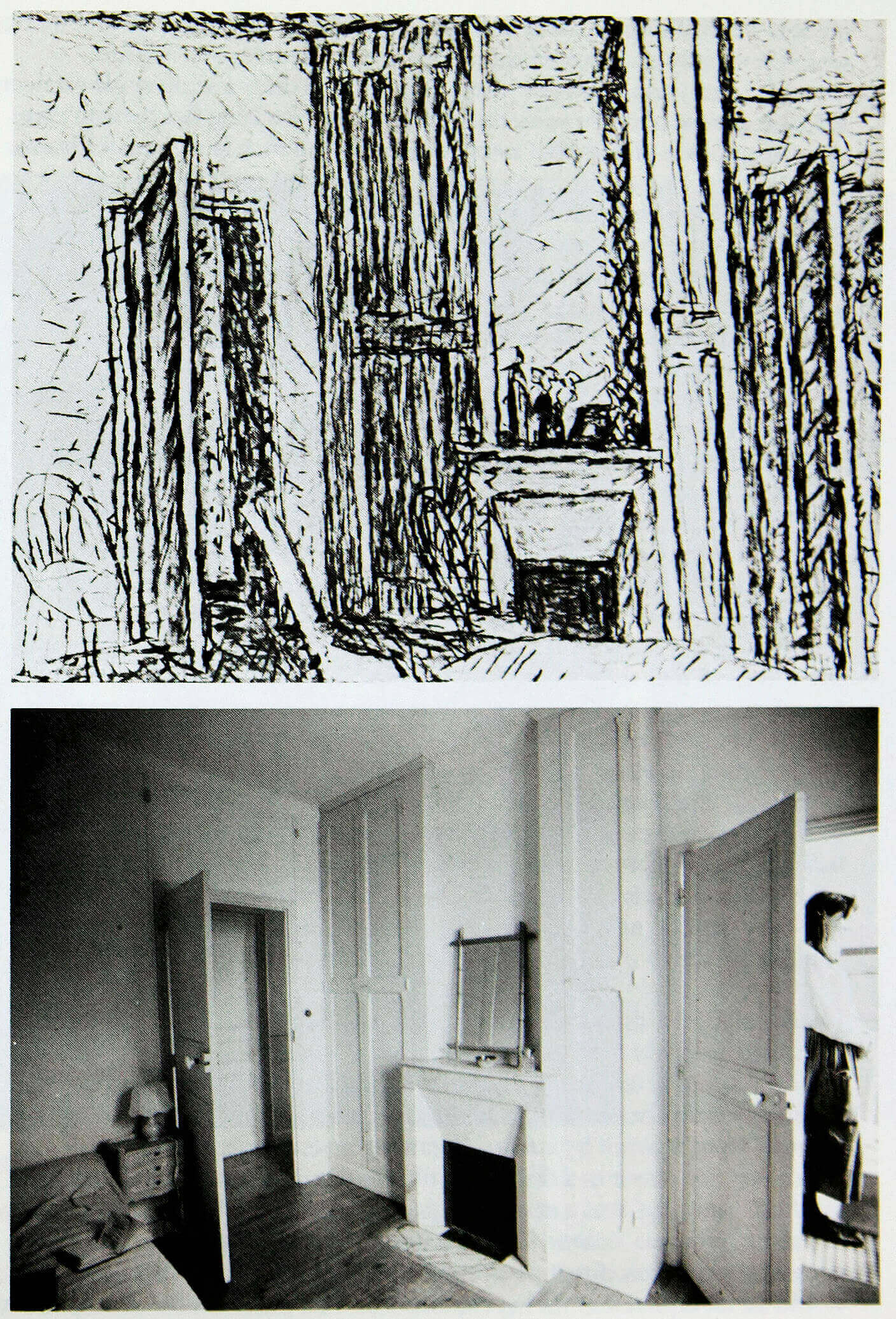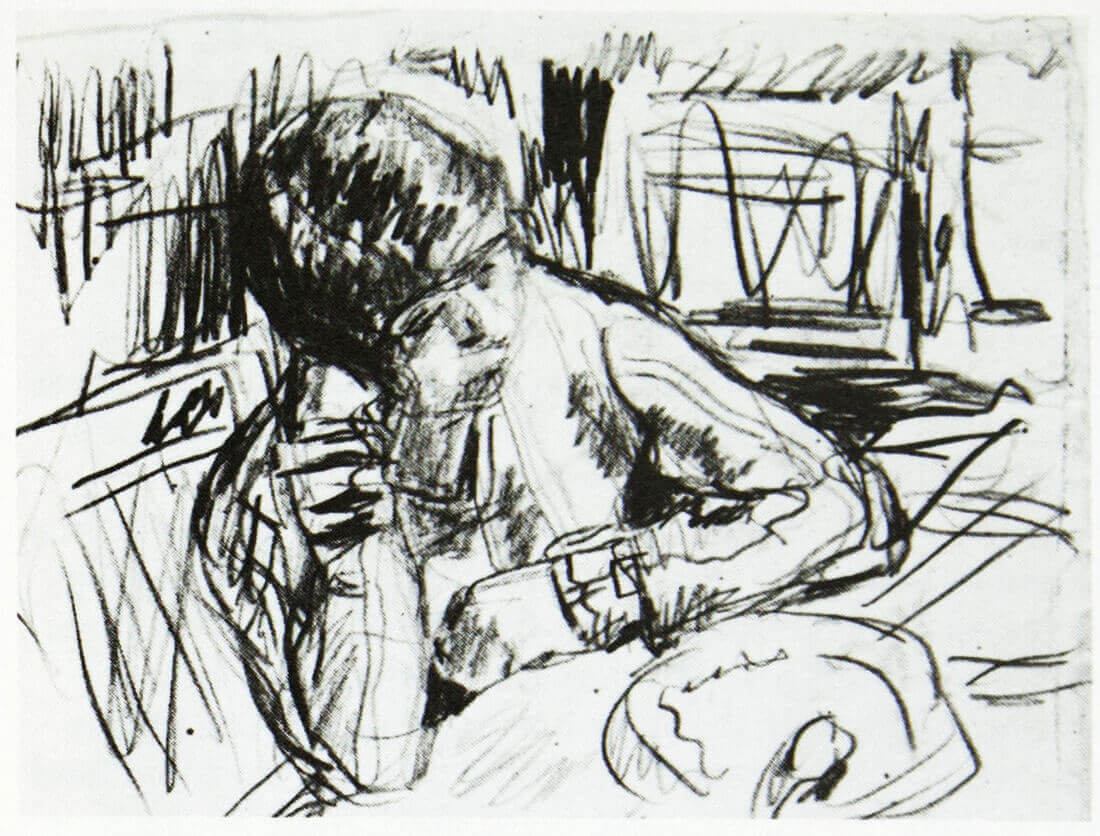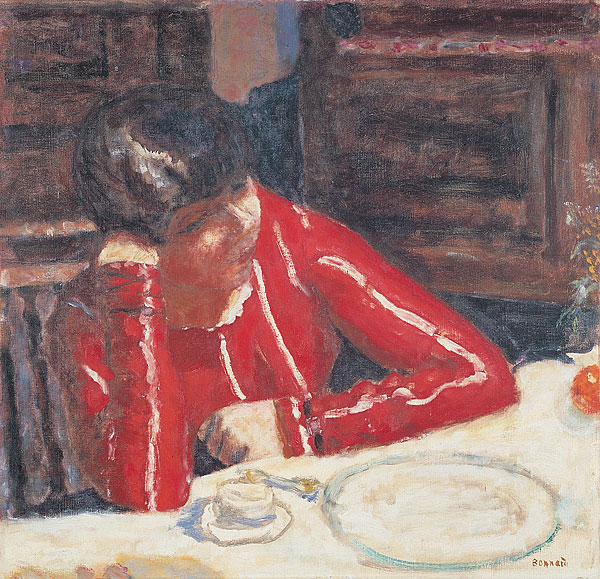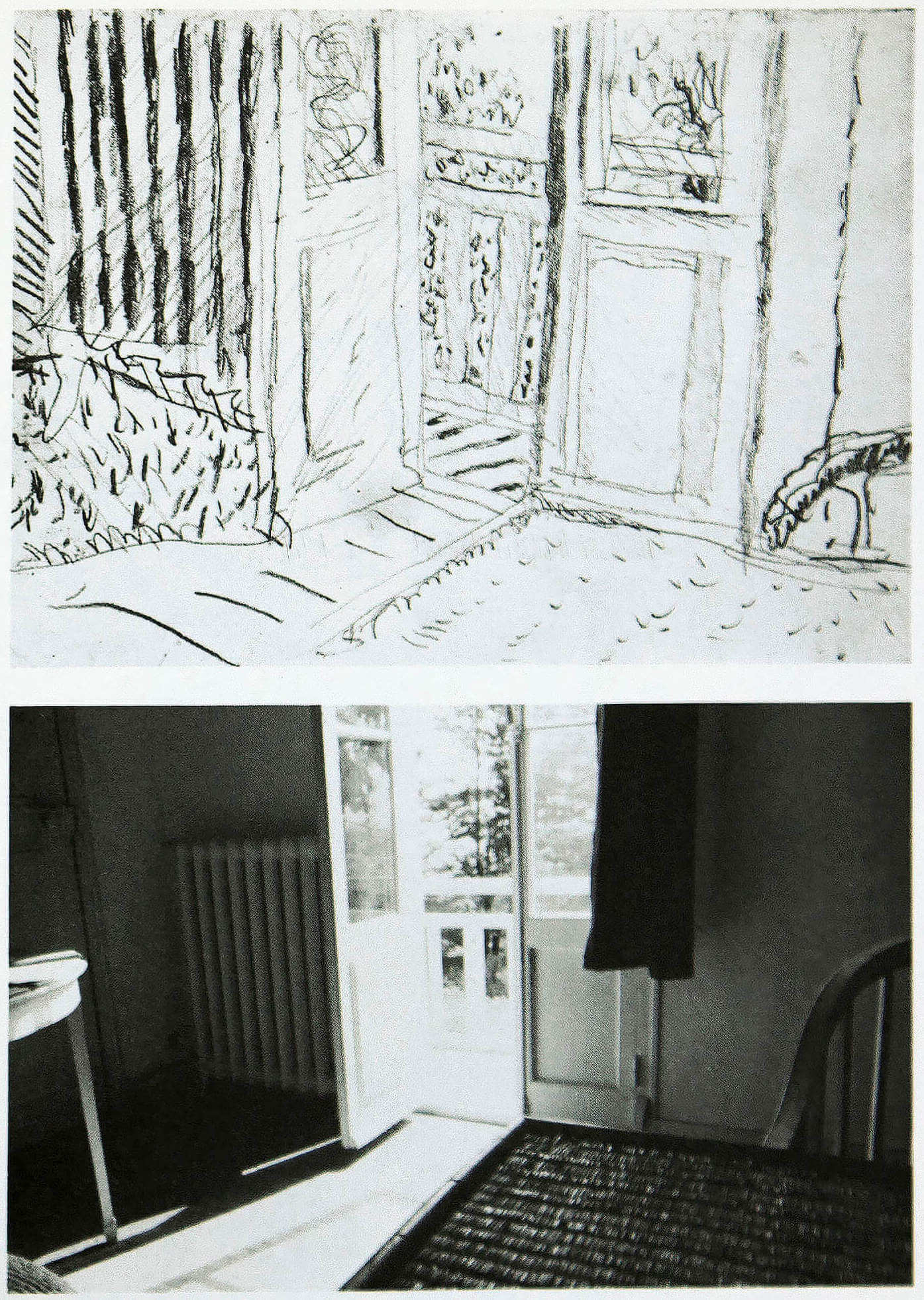The following essay, written in 1984 for an exhibition at the Hayward Gallery in London, is reprinted here as the first in an occasional series featuring important but under-known writings by the painter Sargy Mann (1937- 2015). This series is made possible by the generosity of the Sargy Mann estate. Learn more at sargymannarchive.com
On Bonnard drawings for an exhibition at The Hayward Gallery
Pierre Bonnard is acknowledged to be one of the great masters of modern painting yet as a draughtsman he has been neglected. One reason for this is that he seldom parted with his drawings and even today, thirty seven years after his death, they are not often seen. Another reason is that the very uniqueness of his drawings has distanced them from the popular idea of fine draughtsmanship which is seen as extending from the Italian Renaissance via Ingres and Degas.
Bonnard had an extraordinary natural gift for drawing, and up to the turn of the century it would be fair to say that he was as much a graphic artist as a painter. In 1889 when he was twenty-two he won a competition with his design for a poster for France-Champagne. It was this poster that caught the eye of Toulouse-Lautrec who then met Bonnard and, as a result, himself started making lithographic posters. In the next thirteen years Bonnard made many posters and illustrations for La Revue Blanche and other magazines, made a large set of lithographs published by Ambroise Vollard, illustrated publications for his brother-in-law, the composer Claude Terrasse, and illustrated, very fully, three books. Renoir was so impressed by the first of these, Marie, that he wrote to the young artist, ‘you have a little note of charm, do not neglect it… it is a rare gift’. Later they met and became friends. The illustrations for Marie and Parallelement have a delicacy and charm, together with a formal strength that is reminiscent of Watteau, and it is in this ability to combine all three qualities with such decorative mastery that we can now see the Bonnard that was to come.
Very early on Bonnard stopped painting from direct observation. He felt ‘weak in front of nature’, he said. ‘The presence of the object, the motif, is very cramping for the painter at the moment of painting. The point of departure for a painting being an idea — if the object is there at the time of working, there is always a danger for the artist to allow himself to be too involved in the incidences of the direct view, and in so doing to lose the initial idea.’ And so he painted from memory rekindled by drawings. This ‘weakness’ affected every aspect of his art, his subject-matter as well as how he came to realise it, and led to drawing becoming for him more important than for any other major painter. Bonnard’s paintings are almost always of a particular visual experience, of which he made a drawing at the time, but which he painted in the studio, away from the distractions of the subject. This exhibition is of just such drawings, which are the vital and essential link between Bonnard’s vision of nature and the thrilling coloured metaphors for this vision that he was able to invent in the studio.
Possibly the most remarkable thing about Bonnard’s mature drawings is their ability to communicate coloured experience.
Bonnard drew incessantly, on his daily walks in the country before breakfast, at breakfast, at lunch, at dinner, loafing round the house and garden, in cafés, in the streets, out of windows, in harbours, on beaches, on boats, and in the bathroom. Bonnard’s wife, Marthe, was a difficult and neurotic woman who spent a disproportionate amount of her day in obsessive washing and bathing and it is to this quirk that we owe many of the finest and most original nudes ever painted. Bonnard drew everywhere and at any time – on terrible paper; cheap children’s sketch books, often lined or squared, flimsy numbered pages, envelopes, anything. The drawings are usually made with a soft pencil and tend to be about five inches by six – to fit easily into the pocket, and attract the minimum of attention while being made. George Besson tells us he ‘scrawled them with a burnt match, even a broken pen, but he had a predilection for an indescribably blunt pencil that was so short that a landscape or a nude seemed to spring from the ends of his three fingers compressed around an invisible point’. His need to record on his scrap of paper everything that he would need later in the studio – to respond, and quickly, to any quality he saw – resulted in a drawing ‘language’ of extraordinary variety and richness. No artist before or since has discovered so many different kinds of pencil mark, or ways of combining them. In every sense but the literal one Bonnard’s drawings are paintings. When we compare these drawings with the paintings made from them we begin to see how almost everything is already there, frequently down to some of the smallest divisions of the resulting coloured surface. We find in these so casual seeming drawings, that Bonnard has drawn every highlight in a basket of fruit with little squares or sometimes crosses, that a blurry smudge and a vague scribble result in a violet shadow and a paler bluer one in precisely the same relationship as the smudge and the scribble, that a scattering of dots in two different areas of a drawing results in similar strong, light colours which become fields, near and far, throwing the same intense light towards us, and that even the subtle difference in these colours turns out to be represented in the drawing by a variation in the sharpness and spacing of the dots. Possibly the most remarkable thing about Bonnard’s mature drawings is their ability to communicate coloured experience. It is assumed by most people that since monochromatic drawing cannot actually contain coloured information, the illusion of colour must rely on association, but this is not so. The particular balance of marks which transforms a blank piece of paper into a drawing is the result of everything that was of concern to the artist at the time of making it and if colour is part of this concern then information about it is caught in the drawing along with everything else and is not just there by association. One must not think that if one cannot name the colours then they are not there. If the drawing would have been otherwise had the colour been otherwise, then it is about the colour.


The drawings vary enormously in how hard he worked them. I have seen sketch books in which every page is deeply ridged from Bonnard’s having pressed so hard with his pencil, and others in which the surface has been caressed so delicately all over that they perfectly satisfy his own assertion that ‘To draw, the hand should glide over the paper as light as a shadow’. Some landscapes and still-lifes of great complexity seem to have been made without putting a mark wrong, whereas in other, seemingly quite simple, drawings, he has redrawn contours and re-defined spaces again and again in his search for the right pattern. I don’t think that he cared at all ‘how’ he drew, only that his drawings should tell him what he would want to know.
Bonnard’s habit of drawing all the time, together with his practice of painting from memory rekindled by drawings made on the spot, allowed him to paint subjects of a more transitory nature than had anyone else. With his pencil and scrap of paper he could catch life on the wing — a chance encounter, an effect of light so short lived that Monet would have had no time for it — and then in his studio, he could paint these moments for months, or even years. I have been told by lyric poets that you cannot decide to write a poem, you must simply be alert and wait. When it begins to arrive you have a lot of work on your hands, but you cannot arrange the arrival nor choose what comes. Increasingly I have come to believe that this is how it was for Bonnard. ‘You have to be patient’, he wrote, ‘know how to wait. The emotion will surge up in its own time.’ He didn’t really choose his subjects at all. He went where he liked to be and drew what struck him. His paintings are usually about a particular moment — ‘The work of art — a stop of time’, he wrote in a diary — a chance arrangement of things on the breakfast table, with a figure perhaps, or a landscape as he saw it in the light of an instant, and so they are usually painted from a single drawing, or from more than one made in quick succession on the same occasion. I have seen sets of drawings that are like inspired animated cartoons of what passed before his eyes in a quarter of an hour or so. It is impossible to tell from the look of the drawings which of them became paintings and which did not, and as there are so many more drawings than paintings, it seems likely that it was later that the decision of which to paint was made. Except in the last six months of his life, he never used colour in artificial light, and it would have been in the evenings that he went through the day’s drawings, reliving the moments when once again he had been seduced by nature. From time to time the flame burned so brightly that he knew that he must paint, then he began at once for he was terrified of forgetting. He might start that night to draw in charcoal on canvas pinned on his studio wall (his habitual practice), or perhaps he would wait for tomorrow’s daylight. It was in the evenings too, that he made another sort of drawing. In his diaries, which have a line about the weather each day, he made drawings from memory, and drawings to help him sort out difficulties he was having with the paintings in progress.

Bonnard’s subject matter was strikingly original in two main ways: his predilection for the uncomposed, and the wide, often very wide, angle views that he was struck by and therefore drew and painted. ‘What I am after is the first impression … I want to show all one sees on first entering a room… What the eye takes in at first glance’, he wrote. Thanks to the generosity of M. Michel Terrasse, Bonnard’s great-nephew, I have been able to visit the Villa ‘Le Bosquet’, Bonnard’s house in Le Cannet. Again and again whilst there I found that drawings had been made from doorways, or on rounding a corner, or from wherever Bonnard had happened to be sitting or slouching (Michel Terrasse told me that Bonnard always looked, and was, uncomfortable). In no instance did it seem that he had ‘set up’ or arranged anything, or got into a special position to get a particular view. I had gone with the painter and photographer Tom Espley, in the hope of carefully reconstructing Bonnard’s motifs and photographing them from the precise spot from which he had drawn them. In almost all cases we needed a wide angle lens. For Bonnard, to represent a field of view of 60 degrees was quite common, and eighty to ninety degrees not unusual. I found that two paintings each spanned an incredible 130 degrees from left to right. Fig. 1 shows the drawing from which Bonnard made the gouache which was the study for the lithograph ‘The Yellow Room’, 1942-1946, one of the series put on stone by Jacques Villon. Fig. 2 is our photograph. Bonnard could not have been standing further back as he had just come through a door. The field of view of the drawing is 87 degrees from left to right and the photograph was taken in daylight. Fig. 3 is our photograph for drawing no. 108 in this collection (fig. 4). Bonnard was standing at the top of the stairs joining the two levels of his studio, probably leaning against the wall. The field of view (of the drawing) is about 45 degrees top to bottom, and Bonnard could have just touched the top newel post from where he stood.
‘The [camera] lens records useless lights and shades. The painter’s eye gives objects a human value and reproduces things such as the human eye sees them’.
The shift from the narrow angle views of the Impressionists and Cézanne, whose nearest points tended to be quite some distance away, to the wide-angled views of Bonnard, Matisse, Dufy and Soutine, whose nearest objects were often very close indeed, was a major change in subject matter which is usually overlooked since the names ‘landscape’, ‘still life’, `portrait’, etc., remained the same. If you try to draw a wide angle subject in linear perspective (or something near it) the resulting flat pattern taxes your suspension of disbelief unbearably and you may find, as did Matisse and Bonnard, that a different sort of drawing seems truer to your experience. I can assure you that looking at the Bonnard drawing (fig. 1) is very much more like being in that room than is looking at our photograph (fig. 2) which is in correct perspective. Figurative drawing and painting are always concerned with two things: the subject with all its attendant qualities of space and form, light and colour, and the decorated flat surface which is the only means of expressing this. Any particular convention or style has certain advantages and disadvantages, it is more suited to certain subject qualities than others and leads to surfaces with one sort of decorative appeal rather than another. For Cézanne drawing had had to follow colour rather than lead it — (‘I want to render perspective by means of colour alone’) — and this resulted in a partial break with perspective drawing. This break gave later artists a decorative and expressive freedom by releasing them from a pattern strictly prescribed by the subject’s geometry. The new painting which was more overtly decorative and in which an intuitive colour structure rather than a tonal structure based on a model of appearance was the means of realising form and space, had its origin in Cézanne. It is not ‘an affirmation of the flatness of the picture’s surface at the expense of an illusion of depth and space’, it is simply a different convention for best representing those qualities of his experience that an artist wishes to express. It could not be clearer from reading Matisse and Bonnard (or Cézanne) that they considered themselves to be realists, but they sought new means of expression to assimilate the revitalising influences of primitive and Eastern art, and to enable them to use much more colour, and they needed new means of expression to cope with their new subject-matter of wide angle views and, often, very intense light.

I have spoken of the similarities between Bonnard’s drawings and the paintings he made from them, but there are also striking differences, and these occurred at once in the initial charcoal drawing on the canvas. The main reason for these changes is that the paintings were to be made of colour — were to work by colour. ‘Drawing is sensation. Colour is reasoning’, he wrote in a diary. I think this is a description of his working method: ‘drawing’ was a matter of quickly recording his sensations in front of nature, whereas ‘colour’ (which was only used in his studio, away from nature) was the less direct process of inventing a coloured decoration which would be an equivalent for his experience. The brain is slow to respond to the formal information in colour, it gets pretty well all it needs from tone and drawing (we all know where we are with black and white photographs, films, or television). In arriving at paintings in which an expression of form and space was created by, essentially, the coloured structure, Cézanne, and Bonnard, in his mature paintings, tended to suppress the three dimensional information contained in tone and drawing. This is why many people think their paintings are flat and without depth. If we look at figs. 5 and 6 we can see an example of this which is very common in Bonnard’s case. The strong diagonal of the table edge has been flattened to produce a more frontal seeming painting. In general the drawings seem more immediately perceptual than the paintings and it is in the drawings rather than in the paintings that we are likely first to see how wide is the field of view represented. Had Bonnard made a painting from drawing no. 109 (fig. 4) I am sure that the look down the near newel post would have been less immediately striking (as it is in the drawing compared with the photograph (fig. 3)). On the matter of comparing drawings with photographs, Bonnard said to his nephew Charles Terrasse, ‘To represent on a flat surface masses and objects situated in space, that is the problem of drawing. The solutions are innumerable. Because our vision is above all empirical and conventional. Drawing too is conventional … This conventional reflection of the outside world that drawing gives us is incomparably more true than the dry procedure of photography. The [camera] lens records useless lights and shades. The painter’s eye gives objects a human value and reproduces things such as the human eye sees them’. If we compare no. 77 (fig. 7) with our photographed reconstruction (fig. 8) in which the light is just about right, we can see in the photograph the ‘useless lights and shades’, that Bonnard’s eye has not recorded. What he has done is responded to the variety of light in the subject with the most wonderful invention of different pencil marks so that within the whole drawing each place gives off its own precise illumination. Context of course is everything. Any smallish part of one of his mature drawings is apt to seem like a piece of casual calligraphy without form, or position in space. When the drawing is seen as a whole, however, the meaning of that part is seen to be utterly precise. When the whole is space, the parts have distance; when the whole is an arrangement of masses, the parts have formal particularity; when the whole is light, the parts give off precise values, even colours.

For Bonnard, all drawing and painting was decorative design. The assertion that drawing, however figurative, is design, brought further forward into our consciousness by Cézanne’s heroic struggle — (‘I advance my canvas, understand, together, all at the same time’) — and developed, and explained in words, so eloquently by Matisse, was simply the way Bonnard’s eye’s mind worked. ‘You can take any liberty with line, with form, with proportions, with colours, in order that the feeling (sentiment) is intelligible,’ he wrote in his diary, ‘and clear intentions are nothing.’ And on another day, ‘The practice of cropping of the visual field almost always gives something which doesn’t seem true. Composition at the second degree consists of bringing back certain elements which lie outside the rectangle.’ It is in his drawings that this fusion of the decorative and the figurative is at its most felicitous and in this respect, as in the inventiveness and economy of marks used, his drawings can remind us of Rembrandt’s. Ironically it is Bonnard’s decorative genius that has led many to underestimate his true stature. His paintings are so appealing at first sight, as delightful coloured patterns with pleasing figurative imagery, that many look no longer, or see no further, and for them the magical metamorphosis does not take place; they do not find that they are standing on a little terrace under a walnut tree looking through an overgrown garden straight towards the afternoon sun which is sparkling on the Seine below them, and all looking not as it would to them, but more mysterious, more overpowering, fuller of space and light and colour and overwhelmingly real and harmonious. Bonnard was a realist but his vision was not ours. ‘In clear, cool weather, one often notices a trace of vermilion in the orange-red shadows,’ he wrote. Does one? But he did, and here I would like to quote Professor J. J. Gibson, a leading experimental psychologist, ‘The environment provides an inexhaustible reservoir of information. Some men spend most of their time looking, others listening, and a few connoisseurs spend their time in smelling, tasting or touching. They never come to an end… looking and listening continue to improve with experience. Higher-order variables can still be discovered, even in old age.’ The artist has the genius to communicate this. If we want to enjoy Bonnard’s drawings to the full we must first give up the idea that we know how the world actually looks — as Bonnard himself did — then we can share his discoveries which are not versions but visions. In front of these drawings we can, to some extent, become this extraordinary man who found endless unknown delight in everything he saw.
‘Let it be felt that the painter was there; consciously looking at the objects in their light already conceived from the beginning.’
Pierre Bonnard
